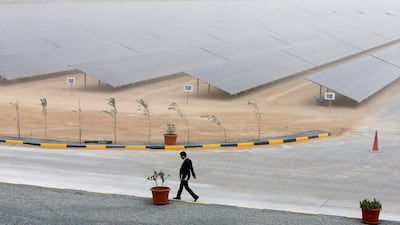The renewable energy market's shift towards maturity, moving away from government subsidies to competitive tendering, raises the risk of unrealistic bids squeezing developers, creditors and utilities, Moody’s Investors Service said.
While the ratings agency points to the growth in the renewable energy market, it also highlights a problematic race to the bottom for the cheapest price.
“With lower tariffs, the margin of error on assumptions for capital costs, project delays, equipment quality, payment delays and curtailment is reduced, and likely to increase project risk,” Moody's said in a report on Wednesday.
Historically, renewable energy projects needed incentives such as government subsidies to be completed. Yet, as technology advances along with an increase in the economies of scale, the price to build and operate renewable energy plants have significantly declined. One example is apparent in the UAE; prices for solar nearly halved in one year with the Mohammed bin Rashid Al Maktoum solar park in Dubai. In 2015, the second phase, some 200MW, was won at 5.84 cents per kWh and then last year the third phase of 800MW came in at 2.99 cents per kWh.
This was in part a result of the cost of debt for infrastructure assets dropping due to the current low interest rate environment. “As debt often accounts for 65 to 85 per cent of a project’s capital base, this has had a positive impact on the cost per kilowatt hour of renewable projects globally,” Moody's said.
________________________________
Read more:
There’s nothing flowery about the renewables bidding bubble
‘Summer special’ sale on solar energy an interesting precedent
Dubai set for world’s cheapest night-time solar power
________________________________
Bloomberg New Energy Finance (BNEF) said that the more interesting story to be told is how the race to the bottom on auction prices means that some developers are very exposed to any deviation from their “assumed rosy scenario”.
Jenny Chase, a solar analyst at BNEF, pointed to Indian developers speculating that the price of modules next year would to be up to 25 US cents per watt, below the actual cost of manufacturing, and how they are now complaining that prices have ticked up into the 30s.
“A rise in the cost of debt would also leave many projects uneconomic,” she said, adding that this only means the projects will not be built. “A recent auction in Brazil for project cancellations resulted in 268MW of solar photovoltaic [PV] projects being cancelled for a penalty of US$16/MWh bid.”
Still, there will be some developments that move forward despite these unrealistic forecasts, exposing the investors to other risks. Some projects will struggle to perform to specifications with the minimal maintenance costs assumed. Financiers may face difficulties to find replacements under the same contractual terms if contractors pull out of the deal as prices fluctuate years after the original signing.
Companies are hedging bets on better, more efficient technology being built to cut costs, which may not happen. Even if the technology advances to the anticipated levels, other problems of using unproven components poses an added liability. Moody’s said that while the sector had matured, the next generation of wind turbines or solar panels present risks by virtue of their limited track record.
The seemingly cavalier current prices not only bring to question the viability of the projects, but failure may find lenders backtracking on their willingness to fund such projects. “While technology costs are in general coming down and performance going up for renewable energy technologies, we could see some high-profile failures to deliver, which could cause new financing problems for projects,” Ms Chase said.

